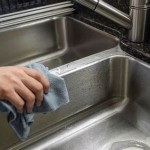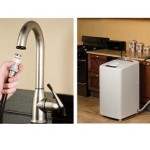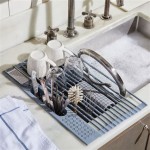Foam Cleaner for Sink Drains: An In-Depth Guide
Sink drains are integral to household plumbing systems, facilitating the removal of wastewater and preventing the accumulation of stagnant, potentially hazardous materials. Over time, however, these drains are susceptible to blockages caused by the build-up of organic matter, grease, hair, soap scum, and other debris. These blockages can lead to slow drainage, unpleasant odors, and, in severe cases, complete drain stoppage. Traditional methods of clearing drains, such as plungers or chemical drain cleaners, can be cumbersome, ineffective, or even damaging to plumbing systems. Foam cleaners for sink drains offer a modern alternative, promising a more efficient and, in some cases, a safer solution for maintaining drain health.
This article explores the composition, mechanism of action, advantages, disadvantages, and proper usage of foam cleaner products specifically designed for sink drains. It aims to provide a comprehensive understanding of this drain cleaning option, enabling informed decisions regarding its application and suitability for various plumbing scenarios.
Understanding the Composition and Functionality of Foam Cleaners
Foam cleaners for sink drains are typically formulated with a combination of ingredients designed to break down organic matter, dissolve grease, and flush debris from drain pipes. These ingredients can vary depending on the specific product and intended use, but some common components include surfactants, enzymes, oxidizing agents, and fragrances.
Surfactants, or surface-active agents, are essential for reducing the surface tension of water, allowing the cleaning solution to penetrate and emulsify grease and other oily substances. This emulsification process allows the grease to be more easily carried away by the flowing water.
Enzymes, often derived from microorganisms, are biological catalysts that accelerate the breakdown of organic matter. Different enzymes target specific types of organic compounds, such as proteins, fats, and carbohydrates. Enzyme-based cleaners are particularly effective at degrading food particles, hair, and other common drain clogging materials.
Oxidizing agents, such as sodium hypochlorite (bleach) or hydrogen peroxide, work by chemically breaking down organic molecules through oxidation. These agents are often used to kill bacteria and fungi that contribute to unpleasant odors in drains. They also help to break down grease and other stubborn deposits.
Fragrances are added to mask the unpleasant odors associated with drain blockages and the chemical reactions of the cleaning agents. These fragrances are usually synthetic and may contain a variety of volatile organic compounds (VOCs).
The foam formulation itself is crucial to the effectiveness of these cleaners. The expanding foam fills the drainpipe, coating the entire surface area, including the upper regions where debris often accumulates. This allows the cleaning agents to more effectively target and break down the blockage. The pressurized foam also helps to dislodge solid particles and flush them down the drain.
Advantages of Using Foam Cleaners for Sink Drains
Foam cleaners offer several advantages over traditional drain cleaning methods, making them an attractive option for homeowners and maintenance professionals alike.
One major advantage is their ability to completely fill the drainpipe, including hard-to-reach areas, maximizing the contact between the cleaning agents and the blockage. This is in contrast to liquid drain cleaners, which may simply flow through the blockage, only partially dissolving it.
Another benefit is the generally reduced risk of damage to plumbing systems. While some foam cleaners may contain corrosive ingredients, many are formulated to be safer for pipes than traditional chemical drain cleaners. Enzyme-based cleaners, in particular, are generally considered to be less harsh on plumbing materials.
Foam cleaners are also relatively easy to use. Most products come in aerosol cans or pre-portioned packets that can be easily poured into the drain. The foam expands on its own, requiring minimal effort from the user. This simplicity makes them accessible to a wide range of users, regardless of their plumbing experience.
Furthermore, foam cleaners can be effective at eliminating odors caused by bacteria and decaying organic matter in drains. The oxidizing agents and fragrances in the foam help to neutralize these odors, leaving the drain smelling fresh. Regular use of foam cleaners can help prevent the build-up of odor-causing bacteria and maintain a clean-smelling drain.
Some foam cleaners are also designed to be environmentally friendly, using biodegradable ingredients and packaging materials. These environmentally conscious options appeal to consumers who are looking for sustainable solutions for their household cleaning needs.
Potential Disadvantages and Considerations Before Use
Despite their advantages, foam cleaners are not without potential drawbacks. Consumers should be aware of these limitations before using them.
The effectiveness of foam cleaners can vary depending on the severity and type of blockage. While they are generally effective at breaking down organic matter and grease, they may not be able to completely clear severe blockages caused by solid objects, such as toys or large amounts of hair. In such cases, mechanical methods, such as using a drain snake or calling a professional plumber, may be necessary.
Some foam cleaners contain harsh chemicals, such as sodium hypochlorite, which can be corrosive and irritating to the skin and eyes. These cleaners should be handled with care, and appropriate safety precautions, such as wearing gloves and eye protection, should be taken. It is also important to avoid mixing foam cleaners with other cleaning products, as this can create dangerous fumes.
The cost of foam cleaners can be higher than traditional liquid drain cleaners. While the added convenience and effectiveness may justify the higher price for some consumers, it is important to consider the cost-effectiveness of different drain cleaning options.
The fragrance in some foam cleaners can be overpowering or unpleasant for some individuals. Those with sensitivities to fragrances should choose unscented or lightly scented options.
Finally, foam cleaners may not be suitable for all types of plumbing systems. Some older pipes may be more susceptible to damage from harsh chemicals. It is important to check the product label and consult with a plumber if you are unsure whether a particular foam cleaner is suitable for your plumbing system.
Proper ventilation is crucial when using foam cleaners, particularly those containing strong chemical agents. Users should ensure adequate airflow in the area where the cleaner is being applied to minimize the inhalation of potentially harmful fumes.
Storage of foam cleaners is also important. The product should be kept out of reach of children and pets to prevent accidental ingestion or contact. The container should be stored in a cool, dry place, away from direct sunlight and heat sources.
Before using a foam cleaner, it is advisable to read the product label carefully and follow the manufacturer's instructions. This will help to ensure that the product is used safely and effectively. If the blockage persists after using a foam cleaner, it is recommended to consult with a professional plumber to diagnose and resolve the problem.
Some foam cleaners can lead to plumbing fixture discoloration or staining if left in contact with surfaces for extended periods. A small, inconspicuous test area should be used before widespread application, particularly on sensitive materials like porcelain or certain metals.
The long-term effects of frequent foam cleaner use on pipe integrity also deserve consideration. While many foam cleaners claim to be safe, repeated exposure to even mild chemicals could contribute to corrosion or degradation over time. Balancing preventative drain maintenance with judicious use of foam cleaners is a sound approach.
Foam cleaners, like all drain solutions, are not a comprehensive substitute for responsible disposal habits. Preventing grease, food scraps, and hair from entering the drain in the first place significantly reduces the likelihood of blockages, thereby decreasing the need for frequent cleaning interventions.
Certain foam cleaners may interact negatively with septic systems. Individuals utilizing septic systems should opt for enzyme-based foam cleaners specifically formulated for septic safety to avoid disrupting the delicate bacterial balance within the septic tank.
Proper disposal of empty foam cleaner containers is essential. Aerosol cans, in particular, often contain residual propellant and may require specific disposal procedures to prevent environmental contamination. Municipal waste management guidelines should be followed.

Drain Cleaner Get Out Foaming Foam For Bathroom Sink Pipe Dredge And Quick 60ml Wal Com

Herios Drain Foam Cleaner Pipe Dredge Deodorant 500ml Magic Liquid Clog Remover Powerful Sink And

Japanese Drain Foam Cleaner For Bathroom Sink Pipe Dredge

Pipe Dredge Deodorant Foam Cleaner Pipeline Plumbing Sink Drain And Foaming Made In China Com

Herios Drain Foam Cleaner Powerful Foaming Sink Cl

Herios Drain Foam Cleaner Pipe Dredge Deodorant 500ml Magic Liquid Clog Remover Powerful Sink And

Drain Cleaner Foam Test And Demo 2024 Does It Work Youtube

Japanese Drain Foam Cleaner Powerful Sink And Liquid Hair Clog Remover Pipe For Kitchen Sinks Tubs

Drain Cleaner Foam Test And Demo 2024 Does It Work

Japanese Drain Foam Cleaner Powerful Sink And Liquid Hair Clog Remover Pipe For Kitchen Sinks Tubs







